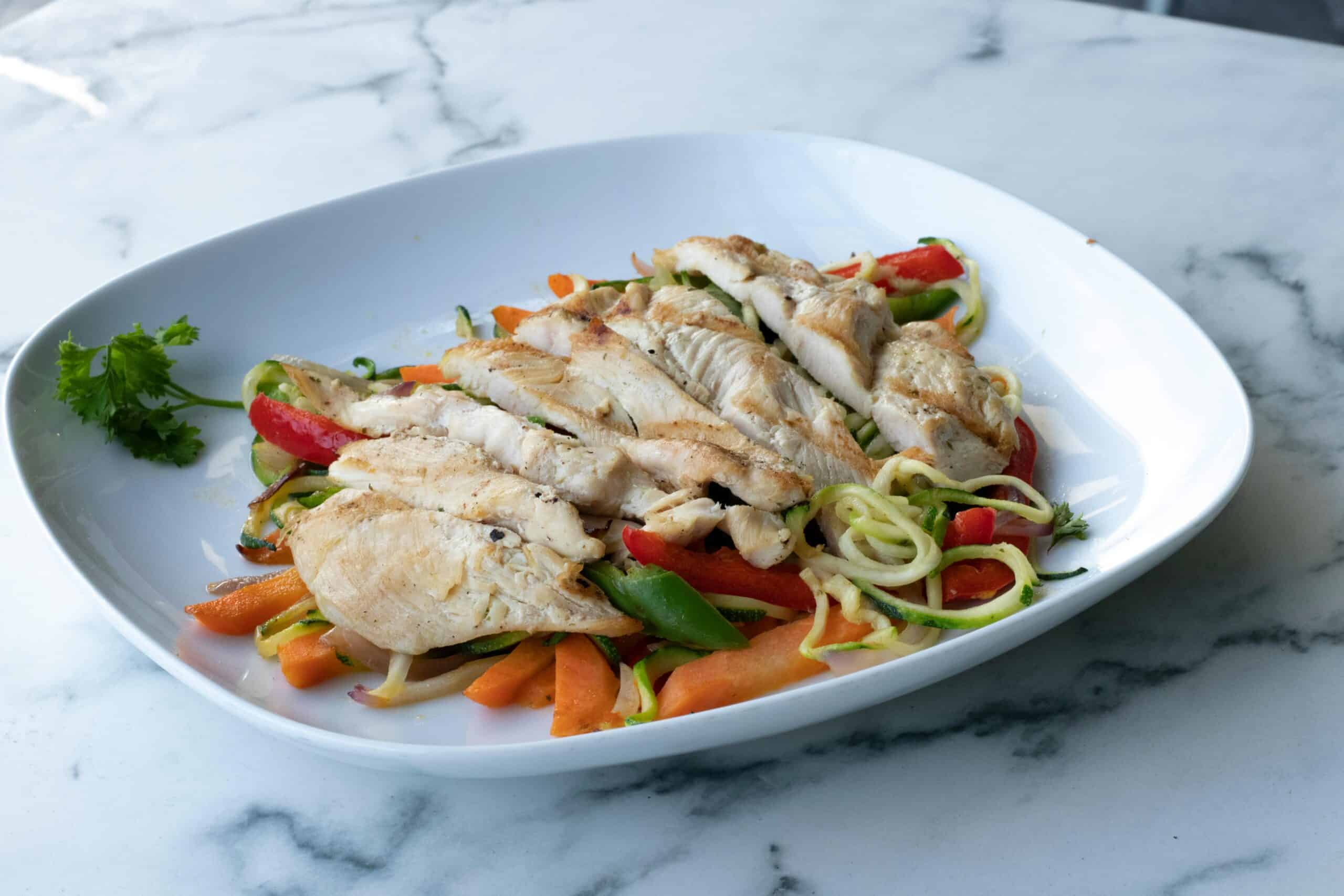Hitting your protein goal is vital to your overall health, wellness, metabolism, and ability to lose weight. We don’t have adequate stores of protein in our bodies, so we have to consume protein every day through the food we eat.
When you don’t eat enough protein, you shut down fat metabolism, which makes it difficult to lose weight. Provide your body with enough protein and you’ll keep your body in a fat-burning mode. But the amount of protein we need can feel like a lot—at first, eating high protein seems impossible within a caloric deficit.
Today, I’ll share with you 33 high-protein, low-calorie food options that will help you reach your goals easily.
How Much Protein Should I Eat Daily?
Your protein needs are personal—it’s kind of like calories. Depending on your sex, weight, size, age, and body composition, you’ll need more or less protein than your neighbor.
A good rule of thumb is to eat the same amount of protein in grams as your goal weight in pounds.
If, for example, you’re a 160-pound woman, but you know you’re 10 pounds overweight, your goal weight is 150 pounds. Your body will benefit, therefore, from 150 grams of protein each day!
Take note: Your body can only consume so much protein in one sitting. Divide your protein goal between three or four meals. A 150-pound woman could, for example, eat 50 grams of protein at breakfast, lunch, and dinner.
Does that seem like a lot? We’re not used to eating that much protein! When we start eating a higher protein diet, we often blow past our calorie limit. Getting the right balance can take a minute. This list will help you find new foods you love that can help you reach your protein goals without overconsuming calories.
Why Can’t I Hit My Protein Goals Without Overeating?
People often tell me, “Amanda, when I increase my protein intake I can’t stay in a caloric deficit!” Let’s take a minute and address the real problem.
Simply put, your protein isn’t to blame. Fat is. Certain sources of protein, like peanut butter, whole eggs, and hemp hearts, are packed with fat.
If you compare the calories within macronutrients, you’ll see what I’m talking about. 1 gram of protein contains 4 calories. 1 gram of fat, on the other hand, contains 9 calories. When you load up on high-fat protein options, you’ll quickly blow past your calorie goal. The solution? Lean protein sources.
When Should I Stick to Low-Calorie High-Protein Food?
This list will be helpful to have on hand regardless of your fitness goals! Protein is critical for our health and wellness. The list below includes healthy, clean, high-protein foods you can enjoy for the rest of your life!
My list, though, is especially helpful when you’re trying to slim down and lose body fat, a.k.a. when you’re living in a temporary caloric deficit.
I use this list too! When I’m leaning out, I might eat fewer whole eggs and more egg whites to reach my macro goals and stay below my calorie limit. Once I reach my goal weight, I can carefully increase my calories and eat more of those higher-fat whole foods again.
Wait, Aren’t Low-Fat Foods Bad For You?
Are you confused about low-fat food? I don’t blame you.
You’ve had your eyes opened about how unhealthy low-fat foods can be. Low-fat foods are often processed foods. When we remove fat from foods, we lose most of the flavor. Food companies add other ingredients, like sugar, salt, and stabilizers, to compensate for the lost flavor and texture.
For example, peanut butter is made by simply grinding whole peanuts. However, low-fat peanut butter removes the fat and replaces it with less healthy ingredients to make it palatable. Removing the fat and adding in additional ingredients turns a once whole food into a processed food.
Low-fat packaged foods are often a bad choice. Other foods, however, can be low-fat without being unhealthy. Take chicken breast. It has much less fat than a chicken wing, but chicken breast is still a whole food with only one ingredient.
Let’s talk about egg whites. While whole eggs are an excellent option, occasionally eating egg whites to increase protein and decrease calories is ok too! Removing the egg yolk won’t add any unhealthy ingredients to your breakfast. You’ll be eating fewer minerals and vitamins than a whole egg offers, but if your goal is weight loss, temporarily eating egg whites to help you reach your goal during a calorie deficit is ok.
Low-fat options can feel sketchy. But today there are so many options available to us at the grocery store, including low-fat dairy products, with clean, healthy, simple ingredients. I’ll link to my favorite options below.
So Am I Saying That Fat is Bad?
Absolutely not! Good fats help us absorb important vitamins, give our bodies energy, and support cell growth. They keep our skin vibrant, our brains sharp, and even our bodies lean!
The way our food is made in America, however, makes it frustratingly easy to overeat carbs, calories, and fat.
Here are a few examples that will make my point clear. Thirty grams of protein from the following foods will cost you this many calories.
- 30 grams of protein from peanut butter = 700 calories
- 30 grams of protein from whole eggs = 350 calories
- 30 grams of protein from hemp hearts = 510 calories
- 30 grams of protein from low-fat cottage cheese = 225 calories
- 30 grams of protein from 93% lean ground beef = 225 calories
- 30 grams of protein from egg whites = 150 calories
Can you see how lean protein options help you hit your protein goals while staying in a caloric deficit?
We can still eat a balanced diet. We just have to put in a little more effort and intentionality during a season of weight loss to lower our calories and increase our protein each day. Some low-fat options can help us get there.
What If I Can’t Eat Dairy or Eggs?
There are still plenty of options for high-protein, low-fat foods. In the list below, I’ve included a long list so that everyone—no matter your food preferences or restrictions—can reach their protein goals!
Low-Calorie, High-Protein Foods That Will Help You Lost Body Fat
Save this list of my personal favorite low-calorie, high-protein foods that you can leverage when trying to cut weight. Some food brands are better than others! Click on the links to find the brands I personally buy that are made with healthy, clean ingredients.
Low-Calorie, High-Protein Meat
- Chicken Breast: 4 oz = 31 grams of protein and 140 calories
- Turkey Breast: 4 oz = 31 grams of protein and 140 calories
- Pork Loin: 4 oz = 23 grams of protein and 130 calories
- Rump Steak: 4 oz = 22 grams of protein and 190 calories
- Ground Beef, 93% lean: 4 oz = 24 grams of protein and 170 calories
- Wild Caught Salmon: 4 oz = 25 grams of protein and 150 calories
- Wild Caught Tuna: 4 oz = 26 grams of protein and 120 calories
- Wild Caught Cod: 4 oz = 25 grams of protein and 120 calories
- Shrimp: 4 oz = 24 grams of protein and 120 calories
- Bone Broth:
- Kettle & Fire Bone Broth Soups: 1 serving = 19 grams of protein and 80 calories
- Kettle & Fire Mushroom Chicken Bone Broth: 1 serving = 19 grams of protein and 100 calories
- Pacific Organic Bone Broth: 1 cup = 9 grams of protein and 50 calories
Low-Calorie, High-Protein Dairy and Eggs
- Egg Whites: ½ cup, raw = 13 grams of protein and 63 calories
- Low-Fat Greek Yogurt: 1 cup = 22 grams of protein and 120 calories
- Low-Fat Skyr Yogurt: 1 cup = 14 grams of protein and 100 calories
- Low-Fat Cottage Cheese: ½ cup = 14 grams of protein and 80 calories
- Park Skim Mozzarella Cheese: ½ cup, shredded = 12 grams of protein and 160 calories
- Low-Fat Kefir: 1 cup = 10 grams of protein and 110 calories
Low-Calorie, High-Protein Plants
- Edamame: 4 oz = 16 grams of protein and 140 calories
- Quinoa: 1 cup, cooked = 8 grams of protein and 220 calories
- White Beans: ½ cup = 8.5 grams of protein and 120 calories
- Tempeh: 3 oz = 18 grams of protein and 160 calories
- Lentils: 4 oz, cooked = 10 grams of protein and 130 calories
- Tofu: 4 oz = 9 grams of protein and 90 calories
- Seitan: 4 oz = 24 grams of protein and 120 calories
- Soy Bean Spaghetti: 1 serving = 25 grams of protein and 180 calories
- Lupini Bean Pasta: 1 serving = 14 grams of protein and 160 calories
- Soy Yogurt: 1 serving = 15 grams of protein and 120 calories
Low-Calorie, High-Protein Supplements
- Collagen Powder: 1 serving = 20 grams of protein and 70 calories
- Vega Vanilla Protein Powder: 1 serving = 20 grams of protein and 120 calories
- Sunwarrior Protein Warrior Blend: 1 serving = 19 grams of proteinand 100 calories
- Natreve Grass-Fed Whey Protein Powder: 1 serving = 28 grams of protein and 140 calories
- Legion Whey Isolate Chocolate Protein Powder: 1 serving = 23 grams of protein and 110 calories
- OWYN Plant-Based Protein Powder: 1 serving = 20 grams of protein and 140 calories
Try This Trick At The Grocery Store…
This quick guide can be used on the fly to help you find high-protein options that won’t break the calorie bank. You’ll be able to know whether any food will fit your macro and calorie goals with a quick glance at the nutrition label. Check out my video where I walk you through this trick, step by step.
Want more guidance on staying lean while remaining in a calorie deficit? Join LEAN, my nutrition and weight loss program that has helped over 131,000 people!



